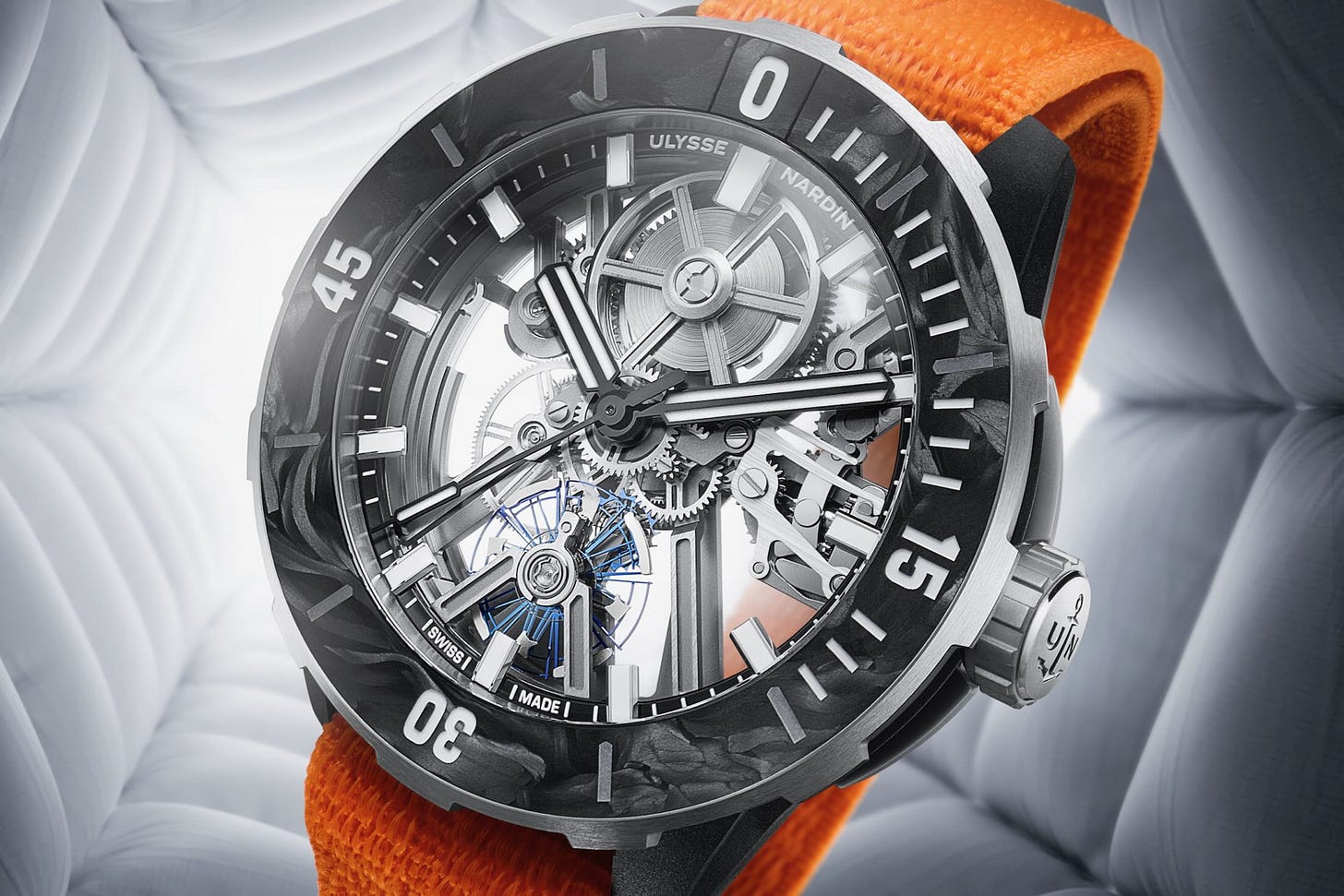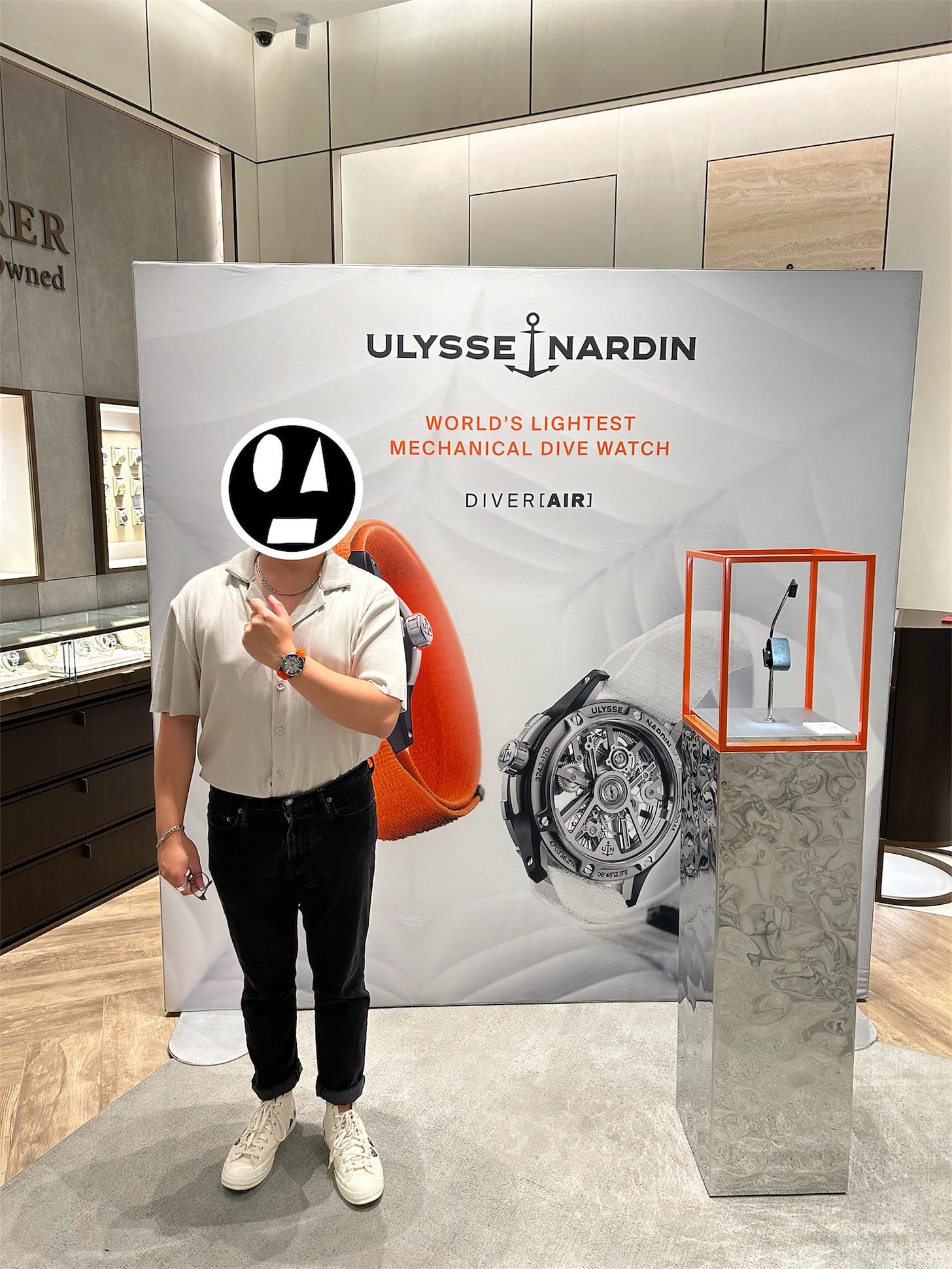I tried on the world’s lightest mechanical dive watch.
“If it’s possible, it’s done. If it’s impossible, it will be done.” — Paul-David Nardin
In pursuit of lightness and technical achievement, titanium has become a sort of magic, auspicious word for tools and gadgets in the same way that SWISS MADE on a watch dial is a dopamine hit for watch collectors.
There are hobbyists who champion the absence of any physical sensation that their knife, phone or watch exist at all on their person, sometimes above all else. I myself prefer a little bit of weight to the things I use and carry, such as a pen, pocket knife or safety razor. The heft in the hand just feels more sturdy to me, and with watches, the weight just feels more premium. I’ve never felt (yet anyways) that a watch was too heavy to wear, even on a bracelet.
Don’t get me wrong, I think titanium is a great material; I have a titanium carabiner that holds all my keys and worn Silhouette and MODO titanium frames that made me forget I even had eyes. Titanium’s hypoallergenic properties also makes it ideal (or the only option) for those who have a nickel allergy or sensitivity to lower-grade stainless steel.
From what I observe in the watch world, titanium is equal parts an engineering marvel as it is a buzzword, even the aha! moment that says to a discerning consumer: this is a well-made and well-engineered product. Of course, while titanium usually commands a higher price tag, I’ve yet to find a watch I really like that I’m willing to pay the higher premium for. I have to like the rest of the design of the watch and if I like it enough, titanium is a bonus rather than the star of the show.
If you couldn’t already tell, I’m not easily swayed by titanium. I’m an aesthetics person first and foremost; to that end, titanium just feels limited in presentation: all spec, but no spic-and-span. Watch cases and bracelets composed of the material are almost exclusively in brushed or satin finishes: perfect for a tough as nails field watch, but not something as versatile as I’d like it to be. Or, a further step is taken where the surfaces are sandblasted to a completely matte texture that reflects little to no light. I just like shiny things, okay?

the record-breaking dive watch, hands-on.
So when I went to my appointment at Bucherer1 to witness the Ulysse Nardin Diver [AIR] for myself, I had some expectation of what the wearing experience would be like: a really, really light watch. I’d been to Bucherer times before to see heralded Patek Philippe and Girard-Perregaux dress watches, and… okay, fine, it was mostly for the sole purpose of being awed by the abyssal dial on the H. Moser Venturer Vantablack2.
Upon arrival I was immediately greeted by the friendly concierge serving champagne and an assortment of hors d’oeurves (had to get the wagyu, of course). I was immediately met with a huge poster display of the main attraction: “WORLD’S LIGHTEST MECHANICAL DIVE WATCH”. The glass case used to encase the watch was vacant, as it was in the hands of another visitor who was being helped. As I waited, I was quickly brought up to speed by an associate regarding the Ulysse Nardin brand history, such as its contributions to the nautical side of horology and firsts in technical innovation: one such example being the Freak, released in 2001 and the first watch to utilize silicon components3 within its movement. Over the next 20 years, many other watchmakers followed suit, such as Tissot, Baume & Mercier, Zenith, and Maurice Lacroix.
Ulysse Nardin’s approach to watchmaking is a relentless pursuit of unorthodox, stupidly complex and stupidly accurate timekeeping.
I finished my glass of champagne and was later directed to another home-run UN model: the Blast, released in 2020, which boasted the brand’s first automatic skeleton tourbillon movement. It’s a top performer, with tighter tolerances than required for COSC certification4.
The other visitor left with a smile and was clearly impressed, and the watch was whisked away to be presented anew. At last, the time had finally come to get hands-on with the world’s lightest mechanical dive watch. To help me better understand the experience, I was given a brief rundown by a concierge on what makes the Diver [AIR] so special:
the watch without the strap weighs in at an insane 46 grams (for reference, your average medium chicken egg in the US is just below 50g).
nearly every component is made from sustainable and upcycled materials, ie. the fabric strap (recycled plastic) and the case, which is of 90% recycled titanium made from nylon and carbon fiber.
the automatic UN-374 movement is a brand new, redesigned caliber weighing only 10g. Weight-saving measures were employed wherever possible (you can see in the image above that the titanium bridge is hollowed-out), without compromising on the diver’s robust 200 meters of water resistance. The movement can withstand shock forces up to 5,000G, and has a power reserve of 90 hours.
With all that in mind, when I finally got to try the Diver [AIR] on, secured on its bright neon orange strap, I couldn’t really believe what I was seeing and feeling. I turned my wrist over and over again in disbelief—this thing was the lightest watch I’d ever worn, and the weight betrayed the significant 44mm case size and nearly 15mm thickness. The movement had the appearance of being suspended in midair within both sides of the sapphire crystal and exhibition caseback. The buttery smooth mechanical movements of the balance spring and machining of the titanium components were absolutely mesmerizing.
I’d given titanium watches a casual wear in boutiques in the past, but definitely not a fair shake. I’ve never owned a titanium watch. I was quite impressed by the Citizen Zenshin Super Titanium, which was not only lightweight but also had the surface treated with DURATECT5 (five times harder than stainless steel, according to Citizen).
This was different. As I walked around the boutique almost forgetting I still had the watch on, I realized the dichotomy of it all: the Diver [AIR] was impossibly airy to wear, but did not give the slightest impression of being delicate or fragile. For a moment I couldn’t really believe this was a full-fledged diver, and just wearing the $38,000 watch—the culmination of ungodly amounts of R&D and unspoken sums of Swiss francs, was surreal. I was wearing a horological world record on my wrist, engineered to the last micron without compromise.
If you haven’t noticed by now, Ulysse Nardin’s approach to watchmaking is a relentless pursuit of unorthodox, stupidly complex and stupidly accurate timekeeping. For that reason, it is a considerably expensive venture to acquire their pieces, with prices ranging from $5,000 to $45,000, to well over $100k.
As a nice touch I was able to have some pictures taken with the Diver [AIR] on (I totally forgot to take one on my phone with it on my wrist). I walked out feeling not only horribly broke and completely out of my batting average, but also with new perspective. Titanium is an incredible material, and the way it can be engineered, shaped and manipulated to house hundreds of minuscule gears, levers and springs is mind-boggling to say the least. For myself and many collectors, both new and seasoned vets, it can be intimidating to step into a luxury watch boutique. If anything, my little hands-on at Bucherer helped to remind me of what I love about watches: they are stories, conversation pieces, memories, and connections all at once.
You don’t have to own an expensive watch to appreciate the engineering and design behind it, and simply trying it on your wrist (as daunting as it may be to ask) gives you an unfiltered understanding of the watch better than any Instagram feed could. Maybe someday I’ll have another opportunity to wear another record-breaking timekeeper.
The Ulysse Nardin Diver [AIR], Ref. 3743-170-2A/0A is available for purchase at authorized retailers such as Bucherer and Burdeen’s Jewelry, for $38,000 at retail, or €37.700 (incl. VAT).
Bucherer: luxury jewelry and watch retailer, founded in Lucerne, Switzerland in 1888 by Carl F. Bucherer. He started producing watches under his name in 1919. In 2018, Bucherer (the boutique) acquired the USA’s largest luxury watch retailer, Torneau, to become the largest watch retailer in the world. In 2024, Bucherer was acquired by Rolex, who then retired the Carl F. Bucherer watch brand in February 2025.
Venturer Vantablack: a model produced by independent watch powerhouse that is H. Moser & Cie. (est. 1928 by Heinrich Moser), headquartered in Schaffhausen, Switzerland. The Vantablack is known by its eponymous black dial that absorbs 99.965% of photons. It’s a marvel to see in photos and in person.
silicon (in watchmaking): Worn & Wound has a great article on watches that have used silicon components following the Freak’s first execution in 2002. Silicon as a rubber/plastic-like material is durable, lightweight, amagnetic, and a silicon escapement wheel boasts longevity and far less maintenance.
COSC certification: COSC standing for Contrôle Officiel Suisse des Chronomètres (Official Swiss Chronometer Testing Authority), and generally referring to mechanical watches. Founded in 1973 and based in Switzerland, COSC is an association that awards a highly precise watch the designation of chronometer upon meeting “several stringent criteria over a testing period of 15 days”.





Amazing article!!! For what I read it must've been quite the experience to wear, essentially, a light egg on the wrist. Oh and if you like shiny Ti check some references from SWC, the hyper g